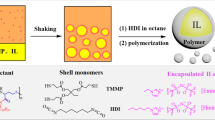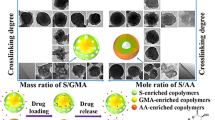Abstract
Colloidosomes have gained intensive attention in the past years due to their substantial applications in wide scopes involving encapsulation, catalysis, and drug delivery, etc. In this study, we depicted the templated fabrication of well-shaped colloidosomes with tunable shell thickness by Pickering emulsion at a mild condition. To this end, toluene-in-water Pickering emulsion stabilized by cetyltrimethylammonium bromide (CTAB)–modified polydopamine (PDA) nanoparticles (PDA@CTAB) was prepared. After the covalent cross-linking of PDA nanoparticles assembled on the surface of an oil droplet through chemical reactions occurring in toluene phase, exclusive intra-colloidosomes were afforded. The shell thickness of colloidsomes could be roughly tuned by the adjustment of the amount of the reactive monomers in the oil phase. Our investigations revealed that CTAB was critical for the successful fabrication of well-shaped colloidosomes. Otherwise, only irregular structures were obtained if pristine PDA–stabilized Pickering emulsion was applied. The current strategy could enable hydrophobic cargo, such as 10-hydroxycamptothecin to be encapsulated while colloidosomes were created. The release behavior of the encapsulated cargoes was also investigated.

CTAB was necessary for the templated fabrication of well-shaped colloidosomes by PDA-stabilized oil-in-water Pickering emulsion







Similar content being viewed by others
References
Lee D, Weitz DA (2010) Double emulsion-templated nanoparticle colloidosomes with selective permeability. Adv. Mater 20:3498–3503
Velev OD, Furusawa K, Nagayama K (1996) Assembly of latex particles by using emulsion droplets as templates. 1. Microstructured hollow spheres. Langmuir 12:2374–2384
Velev OD, Furusawa K, Nagayama K (1996) Assembly of latex particles by using emulsion droplets as templates. 2. Ball-like and composite aggregates. Langmuir 12:2385–2391
Velev OD, Nagayama K (1997) Assembly of latex particles by using emulsion droplet. 3. Reverse (water in oil) system. Langmuir 13:1856–1859
Dinsmore AD, Hsu MF, Nikolaides MG, Marquez M, Bausch AR, Weitz DA (2002) Colloidosomes: selectively permeable capsules composed of colloidal particles. Science 298:1006–1009
Hsu MF, Nikolaides MG, Dinsmore AD, Bausch AR, Gordon VD, Chen X, Hutchinson JW, Weitz DA (2005) Self-assembled shells composed of colloidal particles: fabrication and characterization. Langmuir 21:2963–2970
Laïb S, Routh AF (2008) Fabrication of colloidosomes at low temperature for the encap- sulation of thermally sensitive compounds. J Colloid Interface Sci 317:121–129
Yow HN, Routh AF (2009) Release profiles of encapsulated actives from colloidosomes sintered for various durations. Langmuir 25:159–166
Salari JWO, Heck JV, Klumperman B (2010) Steric stabilization of Pickering emulsions for the efficient synthesis of polymeric microcapsules. Langmuir 26:14929–14936
Williams M, Armes SP (2012) Clay-based colloidosomes. Langmuir 28:1142–1148
Rossier-Miranda FJ, Schroën K, Boom R (2012) Microcapsule production by an hybrid colloidosome-layer-by-layer technique. Food Hydrocoll 27:119–125
Liu H, Gu XY, Hu M, Hu Y, Wang CY (2014) Facile fabrication of nanocomposite microcapsules by combining layer-by-layer self-assembly and Pickering emulsion templating. RSC Adv 4:16751–16758
Cayre OJ, Noble PF, Paunov VN (2004) Fabrication of novel colloidosome microcapsules with gelled aqueous cores. J Mater Chem 14:3351–3355
Noble PF, Cayre OJ, Alargova RG, Velev OD, Paunov VN (2004) Fabrication of “hairy” colloidosomes with shells of polymeric microrods. J Am Chem Soc 126:8092–8093
Duan HW, Wang DY, Sobal NS, Giersig M, Kurth DG, Möhwald H (2005) Magnetic colloidosomes derived from nanoparticle interfacial self-assembly. Nano Lett 5:949–952
Liu HX, Wang CY, Gao QX, Liu XX, Tong Z (2008) Fabrication of novel core-shell hybrid alginate hydrogel beads. Int J Pharm 351:104–112
Bon SAF, Cauvin S, Colver PJ (2007) Colloidosomes as micron-sized polymerisation vessels to create supracolloidal interpenetrating polymer network reinforced capsules. Soft Matter 3:194–199
Chen T, Colver PJ, Bon SAF (2007) Organic–inorganic hybrid hollow spheres prepared from TiO2-stabilized Pickering emulsion polymerization. Adv Mater 19:2286–2289
Chen WB, Liu XY, Liu YS, Kim HI (2010) Synthesis of microcapsules with polystyrene/ ZnO hybrid shell by Pickering emulsion polymerization. Colloid Polym Sci 288:1393–1399
Cayre OJ, Biggs S (2009) Hollow microspheres with binary porous membranes from solid-stabilised emulsion templates. J Mater Chem 19:2724–2728
Croll LM, Stöver HDH (2003) Mechanism of self-assembly and rupture of cross- linked microspheres and microgels at the oil−water interface. Langmuir 19:10077–10080
Croll LM, Stöver HDH (2003) Formation of tectocapsules by assembly and cross- linking of poly(divinylbenzene- a lt -maleic anhydride) spheres at the oil−water Interface. Langmuir 19:5918–5922
Lin Y, Skaff H, Böker A, Dinsmore AD, Emrick T, Russel TP (2003) Ultrathin cross- linked nanoparticle membranes. J Am Chem Soc 125:12690–12691
Thompson KL, Williams M, Armes SP (2015) Colloidosomes: synthesis, properties and applications. J Colloid Interface Sci 447:217–228
Shah RK, Kim JW, Weitz DA (2010) Monodisperse stimuli-responsive colloidosomes by self-assembly of microgels in droplets. Langmuir 26:1561–1565
Samanta B, Patra D, Subramani C, Ofir Y, Yesilbag G, Sanyal A, Rotello VM (2010) Stable magnetic colloidosomes via click-mediated crosslinking of nanoparticles at water-oil interfaces. Small 5:685–688
Zhang Z, Zhang J, Zhang BL, Tang JL (2012) Mussel-inspired functionalization of graphene for synthesizing Ag-polydopamine-graphene nanosheets as antibacterial materials. Nanoscale 5:118–123
Liu XS, Cao JM, Li H, Li JY, Jin Q, Ren KF, Ji J (2013) Mussel-inspired polydopamine: a biocompatible and ultrastable coating for nanoparticles in vivo. ACS Nano 7:9384–9395
Liu YL, Ai KL, Lu LH (2014) Polydopamine and its derivative materials: synthesis and promising applications in energy, environmental, and biomedical fields. Chem Rev 114:5057–5115
Kang SM, Park SJ, Kim D, Park SY, Ruoff RS, Lee H (2011) Simultaneous reduction and surface functionalization of graphene oxide by mussel-inspired chemistry. Adv Funct Mater 21:108–112
Xu J, Ma AJ, Liu TQ, Lu CL, Wang DY, Xu HL (2013) Janus-like Pickering emulsions and their controllable coalescence. Chem Commun 49:10871–10873
Nishizawa N, Kawamura A, Kohri M, Nakamura Y, Fujii S (2016) Polydopamine particle as a particulate emulsifier. Polymers 8:62
Yan J, Yang LP, Lin MF, Ma J, Lu XH, Lee PS (2013) Polydopamine spheres as active templates for convenient synthesis of various nanostructures. Small 9:596–603
Cifuentes A, Bernal JL, Masa JCD (1997) Determination of critical micelle concen- tration values using capillary electrophoresis instrumentation. Anal Chem 69:4271–4274
Drelich J, Fang C, White CL (2002) Measurement of interfacial tension in fluid-fluid systems. Encyclopedia of surface and colloid science 3:3158–3163
Li HB, Yu B, Matsushima H, Hoyle CE, Lowe AB (2009) The thiol−isocyanate click reaction: facile and quantitative access to ω-end-functional poly(N,N-diethylacrylamide) synthesized by RAFT radical polymerization. Macromolecules 42:6537–6542
Li CM, Tan JJ, Li H, Yin DZ, Gu JW, Zhang BL, Zhang QY (2015) Thiol–isocyanate click reaction in a Pickering emulsion: a rapid and efficient route to encapsulation of healing agents. Polym Chem 6:7100–7111
Xu LQ, Yang WJ, Neoh KG, Kang ET, Fu GD (2010) Dopamine-induced reduction and functionalization of graphene oxide nanosheets. Macromolecules 43:8336–8339
Le-Masurier SP, Gody G, Perrier S, Granville AM (2014) One-pot polymer brush synthesis via simultaneous isocyanate coupling chemistry and “grafting from” RAFT polymerization. Polym Chem 5:2816–2823
Funding
The authors thank the financial supports from the National Natural Science Foundation of China (21574112) and the Project of Xiangtan University (2017XZZ36).
Author information
Authors and Affiliations
Corresponding author
Ethics declarations
Conflict of interest
The authors declare that they have no conflict of interest.
Additional information
Publisher’s note
Springer Nature remains neutral with regard to jurisdictional claims in published maps and institutional affiliations.
Rights and permissions
About this article
Cite this article
Liu, P., Qi, C. & Gao, Y. CTAB-assisted fabrication of well-shaped PDA-based colloidosomes. Colloid Polym Sci 297, 1301–1311 (2019). https://doi.org/10.1007/s00396-019-04547-w
Received:
Revised:
Accepted:
Published:
Issue Date:
DOI: https://doi.org/10.1007/s00396-019-04547-w




